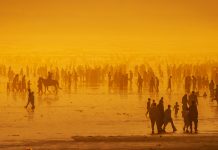By 2030, global demand for fresh water will exceed supply by 40%. A global water crisis looms on the horizon as the world continues its reckless run of “vampiric overuse,” warns a new United Nations report.
In 2005, during my first visit to Spain, the large billboards on the streets of Madrid containing messages about saving water caught my attention. I understood very little Spanish, so I asked my sister if the message on those billboards was the one I thought I had deciphered. I learned then that some regions of the country were facing a drinking water crisis. I don’t remember the messages from that time, but their content was quite similar (and just as powerful) to that of more recent public awareness campaigns about the need to save water (such as, “The Internet does not end, but water does”).
After 36 months of below-average rainfall, some regions of Spain have gone dry, even though, nationally, the drought of the last 12 months is no more severe than what the country faced in 2017, 2012, and 2005. The average water level in Catalonia’s reservoirs is only 27%, and some reservoirs have reached such a low water level that older bridges and even a church tower have begun to emerge in their beds. After 25 months without quantitatively significant rains, the Catalan authorities asked the millions of inhabitants of the region in the north-east of Spain to reduce their water use (by 8% in households, by 15% in industry, and by 40% in agriculture).
Climate change is one of the main factors of the crisis, says Ruben del Campo, the spokesperson of Spain’s National Meteorological Agency (AEMET), emphasising that heat waves are becoming more frequent in this region.
Drought is becoming more widespread in Europe
After a very warm and dry winter, Europe could face a drought comparable to that of 2022, with rains in the coming weeks playing a key role in determining the impact of this dry winter, warns a report from the Joint Research Centre (JRC) of the European Commission, published on March 21. According to the report, drought conditions are being experienced in Greece, Spain, France, Ireland, Great Britain, northern Italy, Switzerland, most of the Mediterranean islands and regions of Romania and Bulgaria on the Black Sea, although insufficient rainfall and reduced river flows affect almost entirely the south and west of the continent.
“A few years ago, I would never have imagined that water would be a problem here in Europe,” said Torsten Mayer-Gürr, one of the authors of a study that analysed the world’s groundwater resources using data obtained by satellite. The report concluded that the water situation in Europe has become “very precarious.”
After Europe faced a severe water shortage in the summers of 2018 and 2019, Europe’s groundwater reserves have remained very low, and the consequences are of a worrying scope—the destruction of natural habitats, damage to agriculture, and aggravation of the energy deficit in Europe. Nuclear power plants in France have struggled to generate enough electricity due to a lack of cooling water, while hydroelectric plants have also had trouble operating due to a lack of water.
What is more, France is experiencing its most extensive dry spell in 60 years—after 32 consecutive days without significant rainfall between January 21 and February 21, the longest period since measurements began in 1959—and could introduce restrictions on water use.
In other parts of the world, the situation is even more complicated, and the water crisis could worsen, according to specialist analyses.
When the crisis hits the most vulnerable among us
“The scientific evidence is that we have a water crisis. We are misusing water, polluting water, and changing the whole global hydrological cycle, through what we are doing to the climate. It’s a triple crisis,” says Johan Rockstrom, director of the Potsdam Institute for Climate Impact Research.
“Water scarcity is becoming endemic,” warns the report published by UN Water and UNESCO. The report was published last week ahead of the first major UN Water Conference since 1977, held in New York from March 22 to 24, attended by some 6,500 delegates, including 100 ministers and several heads of state and government.
Water shortages are caused by overuse, but also by pollution, and seasonal water shortages will be exacerbated both in areas already affected by water shortages and in those that have not yet faced this problem, the report says. According to published data, two billion people do not have access to safe drinking water, and 3.6 billion lack access to safely managed sanitation. The number of people living in cities and experiencing water scarcity is projected to potentially double between 2016 and 2050 (from 930 million to 1.7-2.4 billion people), the document estimates.
There is a “triple threat of water-related crisis” in some regions of Africa, due to lack of safe drinking water resources and sanitation services, increased infant mortality caused by drinking contaminated water, and climate change, the UNICEF report says.
Globally, over 1,000 children under the age of five die every day from diseases caused by polluted water, lack of sanitation and poor hygiene, and the lives of 190 million children are endangered by the water crisis.
“Africa is facing a water catastrophe. While climate and water-related shocks are escalating globally, nowhere else in the world do the risks compound as severely for children,” said UNICEF Director of Programmes Sanjay Wijesekera, warning that, however bad the situation is now, the future could look even worse, in the absence of emergency measures.
The triple threat was found to be most acute in the states of western and central Africa—Benin, Burkina Faso, Cameroon, Chad, Ivory Coast, Guinea, Mali, Niger, Nigeria, and Somalia. The ten countries rank in the top 25% of 163 countries globally with a high risk of exposure to climate threats. Here, temperatures rise 1.5 times faster than the global average, accelerating the multiplication of pathogenic agents, and groundwater levels are dropping. In addition, the Organisation for Economic Co-operation and Development (OECD) classified these countries as fragile or extremely fragile, with armed conflicts slowing down progress related to the provision of safe drinking water or the construction of sewage networks. In the last year alone, 58 water supply points were attacked in Burkina Faso and 830,000 people (more than half of them children) lost access to drinking water.
Cooperation, the best solution to the imminent water crisis
Against the background of low availability and massive demand for water (agriculture alone consumes 70% of water resources), we will surely reach a global water crisis, said Richard Connor, the editor-in-chief of the report, emphasising the need to achieve partnerships to ensure the right of individuals and nations to water.
For her part, UNESCO Director-General, Audrey Azoulay, emphasised the “urgent need to establish strong international mechanisms to prevent the global water crisis from spiralling out of control.”
Asked if global water shortages could trigger wars to control this vital resource, Richard Connor expressed hope that countries will turn to cooperation rather than conflict. Speaking about transboundary cooperation, Connor stated that 153 countries share nearly 900 rivers, lakes and aquifer systems and more than half of them have signed cooperation agreements.
“Cooperation is the heart of sustainable development, and water is an immensely powerful connector,” Connor concluded, stressing that water should not be negotiated like any other commodity, and that discussions are needed for more cooperation in areas such as pollution control, exchange of information, and allocation of funds.
The Global Commission on the Economics of Water (GCEW) has prepared a report for the United Nations water summit, with urgent actions to be taken to stop the imminent water crisis (including managing the planet’s water as a common good, stopping the underpricing of water, reducing the massive annual subsidies for agriculture that often fuel excessive water consumption, and moving to an agriculture that uses water more sustainably, ensuring adequate water for vulnerable populations).
So much has been written about water scarcity that some have become irritated by this topic (as well as others related to environmental crises). However, we cannot pretend that we do not know that 1,000 children die every day because they do not have the necessary water, while we, the privileged part of the world, indulge in “vampiric overuse.” We must not forget that between 1.8 and 2.9 billion people face a severe water shortage for at least 4-6 months annually, and that for 500 million people the water crisis extends throughout the year. And we cannot underestimate the fact that climate change exacerbates water stress and amplifies the risk of water conflicts.
Writing about the Earth, which is becoming “hot, flat and crowded” year after year, journalist Thomas L. Friedman recalled the Chinese proverb that says, “When the winds of change blow, some people build walls and others build windmills.” It is obvious that the winds of change are blowing, but whatever the outcome, we should always bet on windmills.
Carmen Lăiu is an editor at Signs of the Times Romania and ST Network.




















